| |
|
St Peter,
Upwell Outwell becomes
Upwell. The large villages merge, the two long straight
roads head south either side of the long straight River
Nene, swimming against the flow. Occasional bridges cross
between them as if we were in the Low Countries. The
buildings are functional, the product of an industrial
and agricultural settlement whose modern prominence dates
from the late 17th century, and which still has the
puritan flavour of a Flanders town. Until a few years ago
the western side of the river was in Cambridgeshire, but
it is on the eastern bank of the Nene that, just as you
reach the southern limits, you see the glorious octagonal
tower of St Peter rise twice, once into the sky and once
into the water below.
Until the 1960s St Peter was the silent witness to one of
the strangest transport systems East Anglia has known.
This was the Wisbech and Upwell tramway, which trundled
down along the main road through Emneth and Outwell. More
of a train line than a tramway, its passenger service
days ended in the 1920s (although anyone of a certain age
in this area will be able to regale you with stories of
travelling on it after this) and it became the main
distributor of freight throughout this part of the Nene
valley, linking with the main line at Wisbech.
The last tram ran in 1966, and in these days of nostalgia
for steam you might imagine that we lost something
elegant and beautiful, but the W&U trams were
monstrous, bulky things that trundled along the five mile
track like mechanical dinosaurs. They are no doubt more
sadly missed than they were ever fondly loved, and at the
time of their retirement it was perhaps a surprise that
an energetic preservation society sprung into action,
although to no avail. It was led by the Reverend Wilbert
Awdry, vicar of nearby Emneth. He is perhaps best known
today as the author of the Thomas the Tank Engine
books, and a window in Emneth church remembers him.
Today, only road traffic connects Upwell with Wisbech -
that, and the beautiful houseboats that glide silently up
the straight cut of the Nene. And St Peter is beautiful
too. It looks very different to its Outwell neighbour,
but the building scheme was similar. The older tower was
surmounted by a later top storey, and there was even a
spire which fell in the 1840s. Similarly, the body of the
church was rebuilt in several stages, but here the first
rebuilding in the 14th century was done to the south of
the old church, which was then replaced by a north aisle,
at the western end of which the tower stands. The
clerestory was probably added in the 1460s, when medieval
merchant prosperity around here was at its peak.
As at Emneth and Outwell there is an outstanding angel
roof here, and this one is probably the best of the
three. What makes this one more dramatic though is
something even rarer, for you can view the roof at close
quarters by climbing up into the Georgian galleries,
unusual survivals.
 
One of the galleries fills the
north aisle, and there's another at the west end of the
nave. These upper storeys in churches were once much more
common, but the Victorians loathed them and took them out
almost everywhere. The galleries here are of a rich dark
wood, the northern one with a Stuart royal arms set in
the front. The pews in the body of the church below are
contemporary with them, and are rather oppressive in
their magnificence. The chancel gates, also contemporary,
are more delicate.
The galleries are tiered, and if you stand at the back of
the north gallery you are close to the hammer beams and
spandrels of the roof of the north aisle. Even more
imposing than the galleries and pews is one of the
largest pulpits in Norfolk, its sounding board like a
great papal tiara. There is another royal arms, this time
Victorian and carved in dark wood, at the back of the
church.
The roof is not the only medieval survival, for there are
a couple of good brasses to Upwell priests, now remounted
on the walls in the chancel. I must pause to say what I
always say: they would be better on the floor, because in
a fire the heat rises away from floor-mounted brasses.
Wall-mounted ones melt. The medieval font is still in
place, and most significant of all is one of the best of
the west Norfolk 15th century latten eagle lecterns, with
the little lions grinning at its base. A couple of
hundred years later later is the brass in the chancel to
Jane Bell with its charming rhyme. They were obviously
very fond of her.
The chancel was extended as late as the 1880s. The glass,
by Shrigley and Hunt, dates from this time and later,
including a striking WWI memorial window. But above all
else this is a church interior of the early 19th century.
The parish maintains its heritage well, and the smell of
polish and the gleam of varnish are, in this case, wholly
authentic. Contemporary with them is a small brass plaque
in the chancel in memory of sixty seven individuals
of various age and either sex who in the short period
from June 21st to August 13th 1832 died in this rectory
of Asiatic Cholera, a frightful and previously unknown
disease in this country - Reader, why hast thou been
spared? To what purpose hast thou been left until now?
Simon Knott, May 2020
Follow these journeys as they happen at Last Of England
Twitter.
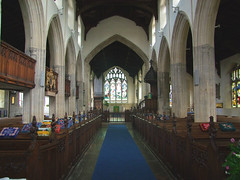  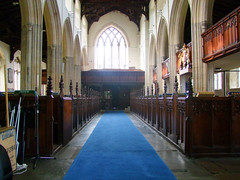
  
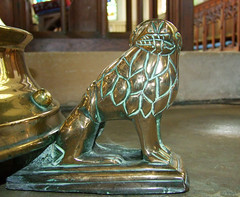  
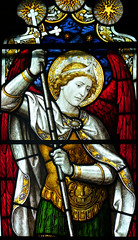  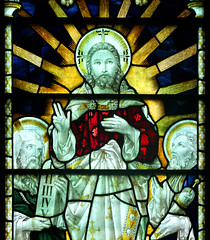  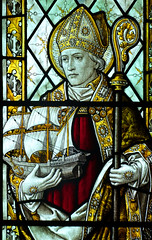
   
  
|
|
|
